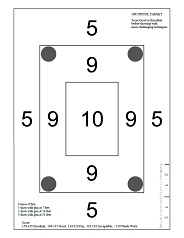Middle Georgia Gun Owner's Association
Twin Oaks Range
4/21/2013 Printable pistol target
12/31/2013 Girl inspiration
If you want to see some amazing shooting, then search these women on YouTube.
According to USPSA (United States Practical Shooting Association) 15% of its members are women.
Jessie Duff (full name Jessie Harrison-Duff, and formerly Jessie Abbate)
Jessie is the Captain for Team Taurus
She is also the first female USPSA Grand Master.
Julie Golob
She is the captain of Smith & Wesson’s shooting team.
She is also sponsored by Benelli.
Tasha Hanish
Tori Nonaka
Became a member of Team Glock at age 15.
Maria Harbin
On the Heckler & Koch team.
Jessica Hook
12/31/2013 Book Review (from club newsletter)
12/31/2013 The gun and ammo drought (from club newsletter)
1/7/2024 Spot Shooting of Handguns By Matt Walker
As a martial arts instructor I am constantly searching for ways to group skills so that they are easy to teach and learn. When it comes to handguns, my focus is accurate self-defense shooting. I found that working on the seven fundamentals of marksmanship was not enough. And, as I found out, it was probably too much work on things that didn’t matter much. I recently stumbled on the concept of spot shooting. If you google search it, you will not get very many results regarding guns. Pistol-training.com is a good website with information on various drills.
Finding this little gem helped bring most of the concepts that I had learned in the past 22 years together into a quickly taught system. The concept of spot shooting is that you need to aim at a small spot no matter how big the target is. Let’s use an 8” steel plate as an example. You move your handgun to cover the plate, align the sights, and pull the trigger. Sometimes you hit it and sometimes you don’t. So you slow down and still occasionally miss. The problem is that you are aiming at the entire 8” plate.
Now take the same plate and visualize a 2” dot in the center of it. When your sights are aligned on the spot you press the trigger. Sometimes you will miss the dot by an inch or two (assuming you didn’t lose sight alignment). This puts your bullets in a 6” circle. You need to be honest with yourself; we tend to shoot worse than we think we do. However, there is hope with effective practice.
Looking at an imaginary dot is not enough; but, it’s a huge start. Out of the seven fundamentals of marksmanship only three are really important for pistol shooting. These are sight alignment, sight picture and trigger control. I will talk more about trigger control in another article about shooting small pocket guns. But, basically the sights should not be moving when the gun fires.
Here’s the formula putting spot shooting and marksmanship skills together: LCP. No, I’m not talking about the Ruger pistol. LCP stands for Look at the dot, Confirm the front sight, Press the trigger. As you begin practicing this, say ‘Look’ ‘Confirm’ and ‘Press’’ as you go through the steps. The LCP cycle works because it is natural. When you are attacked, you will focus on the attacker. Transitioning your focus to the front sight is difficult during stress. We need a way to practice it so that it becomes automatic.
When you get comfortable with the LCP process, you can speed up by just using the word ‘Confirm.’ After looking at the spot say confirm as you change your focus to the front sight. Pull the trigger through the word ‘firm.’ Do the LCP process each time you fire the gun. When you first start to practice this the LCP process may take 1.5 seconds each time. After a few range sessions you can get it down to ½ second between shots at the same spot and under 1 second between multiple targets.
The LCP cycle has these steps: (L) Looking at a visualized dot on our attacker or a target is the first thing. It will be natural to look at him but we need to place a dot on him also. Next, the gun’s sights come up to eye level. (C) Confirm that the front sight is on the dot. Then confirm the rear sight position. (P) Begin pressing the trigger as you focus on the front sight and keep your sight picture lined up. If you chose to use a flash-sighting method then ignore the step about the rear sight.
Now that you have fired your first shot, you will want to shoot it again or shoot at a new spot. Just repeat the LCP cycle. If you move to a new target, then look at the spot first and let the gun follow. Don’t use the sights when moving to a new target. It is too slow.
7/6/2025 Printable A-Zone and down-zero pistol target
This is a letter size target that has the body and head
USPSA A boxes and the IDPA -0 "down zero" circles on it.
They are reduced to 95% to fit on the paper.
It includes two drills you can do.


